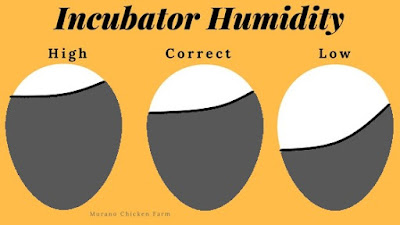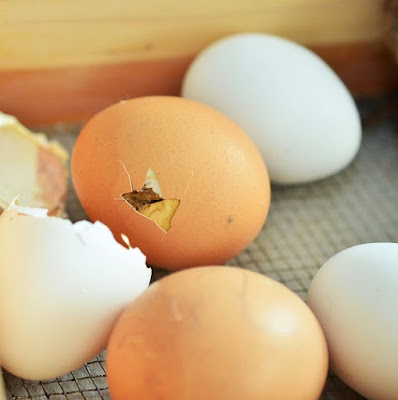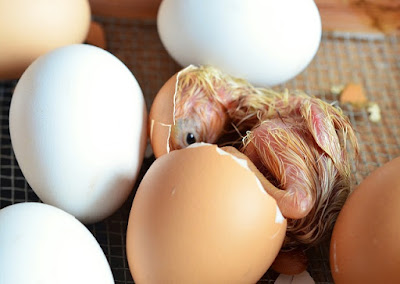Since hatching season is rapidly approaching, I think now is the time to talk about incubating eggs and hatching chicks. First, decide if you should hatch chicks instead of buying them already hatched. Most people choose to incubate eggs that they purchased from a breeder to add a new breed to their flock.
You can buy hatching eggs from a flock clear across the country and have them shipped to you. That's how I get most of my chickens, especially the fancy breeds. Others just like to expand their flock by hatching eggs from their own chickens.
Obviously the easiest way to hatch chicks would be to just let a broody handle the egg hatching. That way you don't have to worry about temperature, humidity and all that jazz. This is easiest if you want to hatch chicks from your own flock. If you don't have a broody though you'll need to use an incubator and that's where it gets a little more complicated.
Related reading: Which incubator should you buy?
Setting up your incubator
First, you'll need to get an incubator. There are two types of incubators. Forced air and still air. Still air incubator means there is no artificial air flow inside the incubator. Forced air incubator means that the incubator has a fan inside it to circulate the air. It's important to know what kind of incubator you have because the temperature requirements are different for each one.
A forced air incubator should be kept at 99-99.5° F. A still air incubator should be kept at 101-102° F, but is measured at the top of the eggs. In a forced air incubator you can measure the air temperature anywhere inside the incubator and it will be accurate since the air is circulating.
In a still air incubator you want to measure the air at the top of the eggs since the heat is coming from above, the eggs are warmer at the top than at the bottom. It's very important to keep the air inside the incubator stable, as even 1 degree difference can terminate the embryos.
You'll want to use a thermometer and a hygrometer. A hygrometer measures the humidity level inside the incubator. Humidity is important during hatch. Keep your humidity between 40-50% for the first 18 dates of incubation. Raise the humidity to 65% for the last 3 days off hatching.
If you happened to buy a Styrofoam incubator and it came with a stick thermometer, throw that out. Those thermometers are pretty well known for being wrong. You can pick a better one up at Walmart for a few bucks. I found a digital one with both temp and humidity readings in the kitchen section for about $5.
The importance of incubator humidity
When an egg is laid an air bubble forms inside it. This air cell is located at the large end of the egg. The air cell is positioned between the shell and the membrane that contains the egg white and yolk.
The chick will break through this membrane to hatch. This air cell helps to alleviate stress and pressure on the embryo as it grows. The air cell get larger as the incubation time passes. Not enough humidity in the incubator and the cell grows too big. Too much humidity and the bubble does not grow at all.
If the air cell doesn't grow to the right size, the chick might not be able to reach it to break through it, and can pip internally and drown in excess fluid. If the air cell is to big, it might trap the chick under it with no room to move. With proper humidity, the air cell will grow properly and this won't be an issue.
To raise humidity inside the incubator, add water to the water reservoir. You could also add a piece of wet sponge. To lower humidity, open the incubator briefly (less than a minute) to allow some air out, unless your incubator is currently in lockdown.
Always check your hygrometer before adding water to the incubator. Humidity inside the incubator is also influenced by the humidity of the room it's kept in and a very humid or arid environment will affect humidity inside the incubator. Don't assume there needs to be a certain level of water in the reservoirs.
If you live in a very humid climate, have had eggs not lose enough moisture during incubation, experienced very low hatch rates or incidences of chicks pipping but drowning before hatching you might want to try the dry incubation method.
All incubators should have vent holes. You'll keep the vents open during the first 18 days of incubation but closed during lock down. Allowing fresh air into the incubator is essential for the eggs. This allows oxygen to come in and the carbon dioxide produced by the developing eggs to go out. The air vents should be open except while in lock down to prevent the chicks from becoming shrink wrapped.
Many incubators have egg turners. Eggs are placed pointed end down in the turners. If your incubator does not have an egg turner, then you will have to lay the eggs on their side and turn them by hand. I turn my eggs 3 or 5 times a day. Always turn them an odd number of turns each day.
Obviously the eggs will not be turned while you're sleeping. By turning them an odd number of turns during the day, it insured they will rest on opposite sides each night. You do not want them resting on the same side 2 nights in a row. To insure the eggs are turned fully, I use a pencil to write an X on one side and an O on the other.
Chicken eggs must be turned during the first 18 dates of incubation to insure that the chick develops properly. If the egg is not turned often enough, the developing embryo can stick to the shell membrane causing abnormal growth.
If you think you may have a hard time keeping track of egg turning, I created an incubation tracker and it's available on Etsy.A chicken egg incubates for around 21 days to form a chick. If you are hatching ducks, geese, guineas or quail they need around 28 days to incubate. I say 'around' because they can hatch up to 2 days early or 2 days late and still be considered 'on time'.
How to hatch chicken eggs
Chose clean, fertilized eggs that are less than 10 days old to incubate. Do not wash the eggs. Washing eggs removes the 'bloom' which is a natural, protective coating. Do not incubate cracked, damaged or misshapen eggs. Here's more information on how to handle hatching eggs before incubation.
Place your incubator in a draft free room out of direct sunlight. Turn your incubator on (and the egg turner if it has separate controls) 24-48 hours before setting eggs.
Check the temperature several times and make sure it stays steady for at least 12 hours before setting eggs. The incubator should be kept at 99-99.5 F for forced air and 101-102 F for a still air incubator.
The temperature inside your incubator will drop when you first put the new eggs in it. This is normal. Don't touch the controls, it will come back to the correct temperature as soon as the eggs warm up.
Keep the humidity in the incubator between 40-50% for the first 18 days. If your incubator does not have an egg turner, turn the eggs 3-5 times a day.
I like to candle my eggs after 1 week of incubation, though you can often see development after just 3 days. Using a strong flashlight or a candling light, look inside the egg. It helps if you're in a dark room. You should see a darkened blob with what looks like a red spider. It might also have a black spot in it.
Dispose of any eggs that are not developing by day 10. Return the developing eggs to the incubator. Try to move quickly so the eggs do not get too cold.
Removing eggs that have stopped developing is important during incubation and right before lockdown. When an egg stops developing it starts to decompose. This can cause pressure to build up and the eggshell can pop open.
If an egg breaks open inside your incubator it could ruin the rest of the hatch. You want to remove these before they have a chance to pop as they smell really bad and are hard to clean up.
After day 18 stop turning the eggs. If you have a removable turner, take it out. Once you remove the turner make sure the temperature in the incubator doesn't drop, since egg turners sometimes have a motor that creates heat and adds to the incubators temperature.
You will have to carefully adjust the incubator temperature if it gets too low. If your eggs are in suspended turning trays (like in a cabinet incubator) move them to the hatching area. Candle the eggs one last time and remove ones that have quit developing.
Raise the humidity in the incubator to 65% by adding water to the water reservoir. If you can’t get the humidity high enough with the water reservoir alone, you can also add a piece of wet sponge. You'll probably have to add water during the days of lock down so try to position the sponge to make it easy.
I like to put a piece of non-slip material in the bottom of the hatcher (under the eggs) so the chicks can get a good grip with their little feet. It helps to prevent spraddle leg. Rubber shelf liner works great for this, or a thick washcloth.
What is lockdown?
From day 19 till about day 24 is considered "lock down". This is the crucial time while the chicks are hatching. If you open the incubator during this time it can let the humidity out drying the membrane of the hatching chicks. Once the membrane dries, the chicks are unable to move and can get stuck in their shells. This is called shrink wrapped.
The chicken egg hatching process starts around day 18 as the chick gets ready to hatch. Somewhere around day 21, the chick will peck a hole in the egg with the little egg tooth on his beak. This is called pipping.
Sometimes you will hear chirping even before they pip through the shell! After they pip through the shell, they will slowly peck their way around the shell breaking through it all the way around. This is called zipping. They will then push the top off the egg and pop out.
There really is no 'typical' hatch. Sometimes a chick will pip and zip in an hour. Others will pip then rest a few hours before they start zipping. Others will partially zip then rest. A chick can take up to 24 hours to hatch.
Leave newly hatched chicks in the incubator until they're completely dry and fluffy. They can be moved to the brooder after 24 hours.
You'll need to clean your incubator after each hatch. I have instructions for cleaning Styrofoam and plastic incubators. An incubator free of bacteria and debris gets a much better hatch rate.
These instructions are for hatching chicken eggs, but it will be about the same when hatching other poultry eggs...except the length of incubation time might be different. If you want to hatch ducks, quail, guineas or other fowl check this chart from Incubator Warehouse for exact hatching details.
Happy hatching and if it's your first time check out How to raise chicks for beginners.
~L
Here's a complete list of incubation and hatching terms and definitions in case I mentioned anything you're unfamiliar with.
Want information on raising chickens sent right to your email weekly? Click right here to join my list and get new posts sent directly to you the day they're published ... plus, you'll also get the free download '25 Ways to save money raising chickens'.







No comments:
Post a Comment